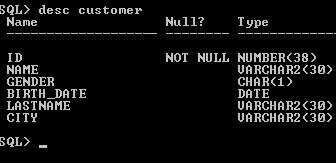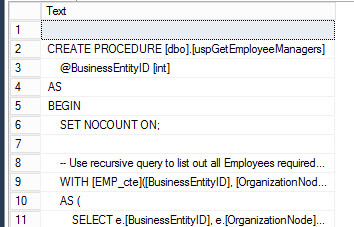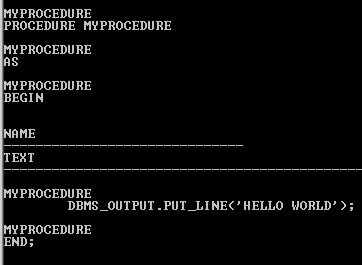By: Daniel Calbimonte | Comments | Related: > SQL Server and Oracle Comparison
Problem
I am working on both SQL Server and Oracle databases. I know many of the concepts are the same, but I am not sure how to build the code I need to complete my daily tasks. Can you provide some insight into SQL Server vs. Oracle?
Solution
In this tip of the SQL Server and Oracle comparison series, we will see how T-SQL compares to PL-SQL for:
- Table Creation
- Comment Code
- Accessing the Top 5 Rows of a Table
- Create a Function
- Call a Function
- Table Information
- Get Object Code
- Looping
- Save Query Results in a Text File
- IF, ELSIF, ELSE Clauses
Table Creation in SQL Server vs. Oracle
In our examples, we will use the customer and products table. Here are the corresponding scripts:
SQL Server |
Oracle |
|---|---|
|
CREATE TABLE customer |
CREATE TABLE customer CITY VARCHAR2(30) DEFAULT 'NY' |
SQL Server |
Oracle |
|---|---|
|
create table product |
create table product |
Comment Code in SQL Server vs. Oracle
SQL Server |
Oracle |
|---|---|
|
--This is a comment for 1 in SQL Server line /*This is a comment in SQL Server multiple lines of T-SQL code*/ |
--In Oracle it is the same /*In Oracle the comments used in PL-SQL are the same than in SQL Server*/ |
Return the Top 5 Rows in a Table in SQL Server vs. Oracle
SQL Server |
Oracle |
|---|---|
SELECT TOP 5 name from customer |
SELECT from customer |
Create a Function in SQL Server vs. Oracle
A function is a routine with a name that accepts parameters and return tables or values and includes calculations to perform different operations used in the code. The functions can be part of an expression.
The following functions receives a price value and calculates the price including the taxes of 30 %.
SQL Server |
Oracle |
|---|---|
|
CREATE FUNCTION price_with_taxes(@price float) In SQL Server there are several types of functions. CLR Functions, Scalar, Inline table-valued, Multi-statemedt Table-Valued. For more information, refer to this link. |
CREATE OR REPLACE FUNCTION price_with_taxes(price IN NUMBER) |
Call a Function in SQL Server vs. Oracle
SQL Server |
Oracle |
|---|---|
|
select dbo.price_with_taxes(price) from product GO |
select price_with_taxes(price) from product; |
Table Information in SQL Server vs. Oracle
SQL Server |
Oracle |
|---|---|
|
sp_help customer GO The result will be similar to this one:  |
desc customer; The result will be similar to this one:  |
Get Object Code in SQL Server vs. Oracle
SQL Server |
Oracle |
|---|---|
|
sp_helptext object_name  It returns the code of existing procedures, functions. It is not applicable to tables. |
Select name,text from user_source where name='object_name'  |
Loops in SQL Server vs. Oracle
The loops can be used to iterate statements multiple times.
SQL Server |
Oracle |
|---|---|
|
declare @value int=1 SELECT @value In SQL Server a loop is like a cursor and a cursor in SQL Server is slow and resource intensive. It is not recommended for high volumes or data. You can safely use while clauses for small amounts of data. |
declare select sum(price) into total from product; In oracle are many sentences to create loops like while loops, basic loops, for loops, etc. For more information about loops, refer to the loops documentation. For bigger amounts of data you can work with batches. For more information refer to this link. |
Save Query Results in a Text File in SQL Server vs. Oracle
SQL Server |
Oracle |
|---|---|
|
1. Save this query in a file named customerquery.sql: USE DB2 2. Now in the cmd run this command: sqlcmd -i c:\scripts\customerquery.sql -o c:\scripts\results.txt |
1. First enable the spool and specify a path: spool c:\Oracle; An Oracle.lst will be created. 2. Now, write a query. select * from customer; 3. Disable the spool. spool off; 4. Check the c:\oracle.lst file results.
|
IF, ELSIF, ELSE Clauses in SQL Server vs. Oracle
SQL Server |
Oracle |
|---|---|
|
In SQL Server you only have IF and ELSE. IF is used in the code for conditions. For example, if the value is higher than 5 (IF @value>5). In SQL Server you can have several if conditions. When a condition occurs, some sentences are executed. ELSE is used if the IF condition(s) does not occur. ELSE is used at the END of the if conditions. /*This sample shows the water state according to the temperature*/ declare temperature int; IF @temperature between 1 and 99 ELSE select @state END |
In Oracle, the use of IF AND ELSE statements is the same than in SQL Server, but you have also ELSIF statements. The ELSIF are used after the first IF. In Oracle, you have an if at the beginning of the statement and you can have several ELSIF conditions later. DECLARE temperature number(3):=0; END IF; |
Next Steps
For more information about T-SQL and PL-SQL, refer to the following links:
- Check out the first tip in this series
- http://docs.oracle.com/cd/E11882_01/appdev.112/e25519/toc.htm
- http://technet.microsoft.com/en-us/library/ms189826%28v=sql.90%29.aspx
About the author
 Daniel Calbimonte is a Microsoft SQL Server MVP, Microsoft Certified Trainer and 6-time Microsoft Certified IT Professional. Daniel started his career in 2001 and has worked with SQL Server 6.0 to 2022. Daniel is a DBA as well as specializes in Business Intelligence (SSIS, SSAS, SSRS) technologies.
Daniel Calbimonte is a Microsoft SQL Server MVP, Microsoft Certified Trainer and 6-time Microsoft Certified IT Professional. Daniel started his career in 2001 and has worked with SQL Server 6.0 to 2022. Daniel is a DBA as well as specializes in Business Intelligence (SSIS, SSAS, SSRS) technologies.This author pledges the content of this article is based on professional experience and not AI generated.
View all my tips






